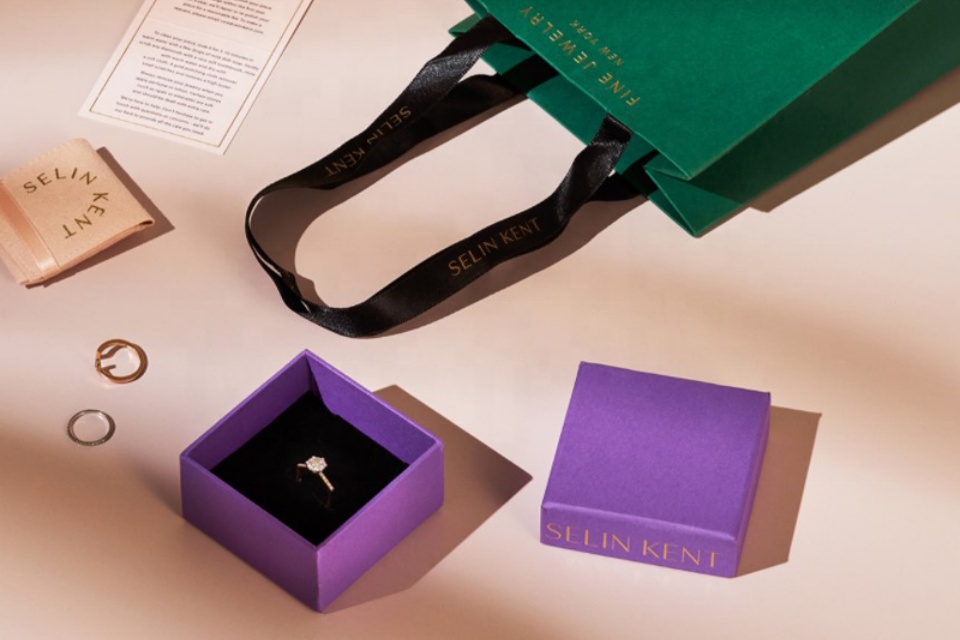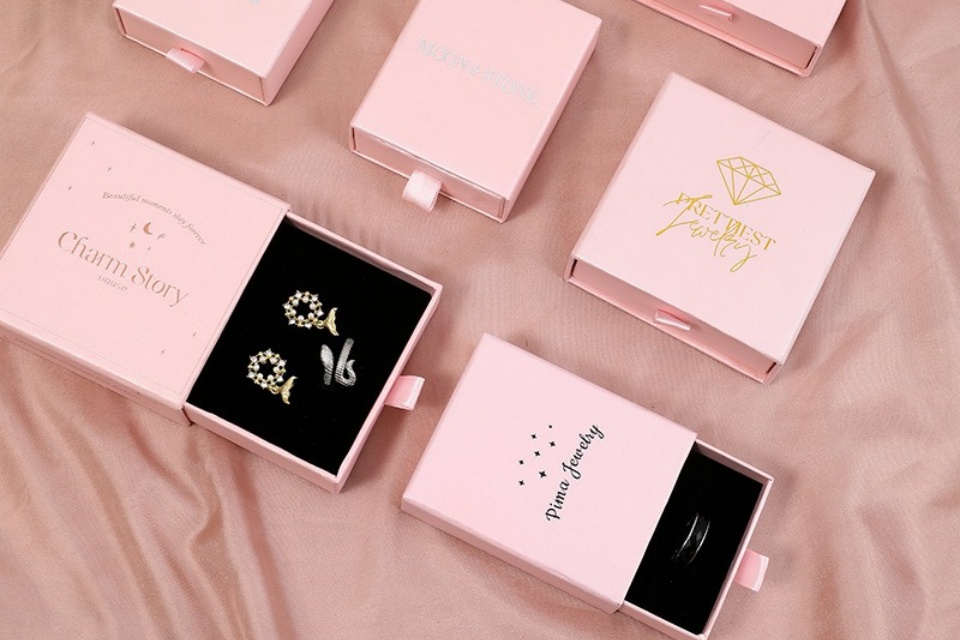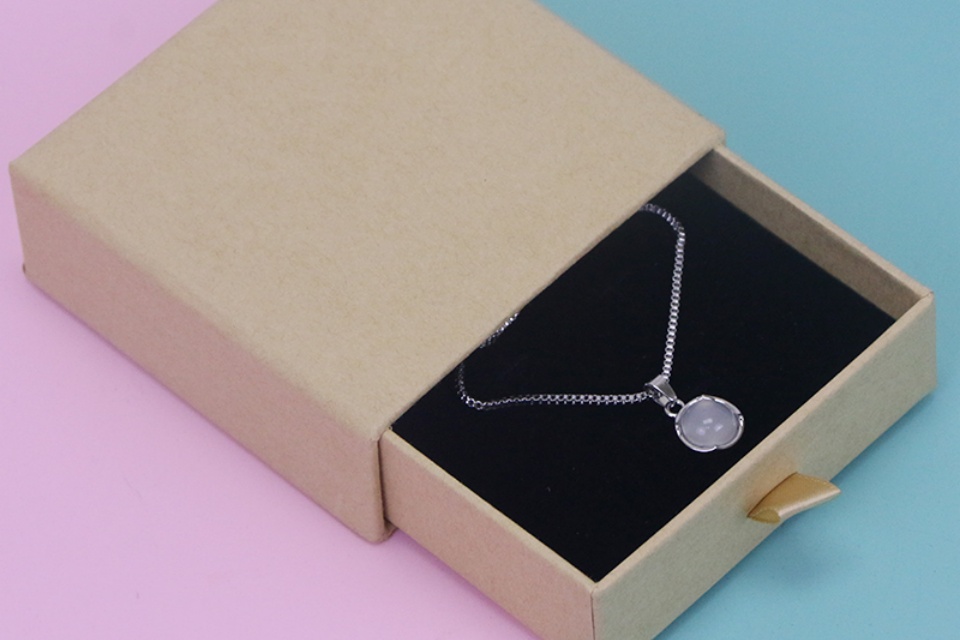Our News
Luxury Jewelry Packaging Design Tips
Luxury Jewelry Packaging Design Tips
Summary
Luxury jewelry packaging design is a critical aspect of the high-end retail experience, serving not only to protect valuable items but also to enhance their perceived worth through elegant presentation. As consumers increasingly seek products that reflect their values and tastes, the importance of sophisticated packaging has surged, positioning it as a vital marketing tool for luxury brands. Effective packaging communicates a brand's identity, creates memorable unboxing experiences, and ultimately influences purchasing decisions in a competitive marketplace.
Key elements of successful luxury jewelry packaging include material selection, typography, personalization, and the overall unboxing experience. High-quality materials such as rigid boxes, velvet, and eco-friendly options convey sophistication and sustainability, appealing to today's ethically conscious consumers. Typography choices, often enhanced with metallic finishes, further elevate the visual impact and reinforce brand identity. Personal touches, like handwritten notes or custom monograms, deepen emotional connections with customers, transforming the unboxing into a cherished occasion.
However, the luxury packaging industry faces notable controversies and challenges, including the push for sustainability amidst consumer demand for premium aesthetics. Brands are now compelled to balance high-quality materials with eco-friendly practices, a shift that has resulted in innovations such as biodegradable packaging and recyclable elements. Additionally, as technology advances, the incorporation of interactive features—such as QR codes—has become a trend, engaging consumers in new ways but also raising questions about the implications for traditional packaging craftsmanship.
In conclusion, luxury jewelry packaging design is a multifaceted discipline that blends art, branding, and functionality, with an increasing focus on sustainability and consumer engagement. As the market evolves, brands must navigate the complexities of consumer expectations and environmental responsibility while crafting packaging that embodies the elegance and exclusivity inherent to luxury jewelry.
Elements of Elegant High-End Presentation
Creating an elegant high-end presentation for luxury jewelry packaging involves several critical elements that enhance the perceived value and customer experience. These elements combine aesthetics, materials, and sustainability to achieve a memorable unboxing experience.
Material Choices
The choice of materials significantly influences the overall elegance of jewelry packaging. High-quality options such as rigid boxes, textured paper, and premium fabrics can elevate the presentation. For instance, rigid boxes are thick and durable, giving a polished look that is synonymous with luxury. Velvet and suede linings offer a soft touch that enhances the visual and tactile appeal, making the packaging feel sophisticated and protective. Additionally, eco-friendly materials like recycled luxury boards demonstrate a commitment to sustainability, attracting ethically conscious consumers while maintaining a high-end finish.
Typography and Finishes
Typography plays a vital role in luxury packaging design. Elegant serif fonts or fancy typefaces, often embellished with gold or silver foil, convey sophistication and attention to detail. The choice of textures and finishes—such as embossing, spot UV, and matte or glossy lamination—adds depth and richness to the packaging, making it visually striking and more appealing to customers. These elements work together to create an organized and calm presentation that resonates with high-end branding.
Personalization and Sentimentality
To establish a feeling of exclusivity, brands often incorporate personalized elements into their packaging. This can include handwritten notes or unique monograms that honor the recipient's preferences or commemorate special occasions. Personalization adds an extra layer of sentimentality, transforming the unboxing experience into a cherished memory. By paying attention to these details, brands create a deeper emotional connection with their customers.
The Unboxing Experience
The unboxing experience has become a key design strategy in luxury packaging. It is essential to consider how the jewelry is revealed within the packaging. Thoughtful design can turn the act of opening a box into a memorable event, increasing customer satisfaction and brand loyalty. The layering of materials, such as soft fabric inserts or protective padding, enhances this experience by ensuring the jewelry remains secure and pristine during transit.
Design Principles
Human-Centric Design
In the realm of luxury jewelry packaging, the focus on human-centric design is paramount. This design trend emphasizes the authenticity of human craftsmanship as a counterbalance to the increasing reliance on artificial intelligence in design processes. Brands aim to convey that their products are "made by humans, for humans," fostering a connection with consumers who desire genuine, relatable experiences. This principle is exemplified by packaging that mimics traditional techniques, such as lino and woodcut prints, which introduce unique textures and imperfections that evoke a handmade quality. Digital techniques are utilized to replicate these characteristics, ensuring the packaging feels personable and warm.
Minimalism and White Space
Minimalism plays a critical role in luxury packaging design, where white space is not merely an absence of elements but a deliberate choice that conveys confidence and sophistication. This approach is particularly effective in distinguishing luxury brands from mass-market competitors. The intentional use of white space enhances the perceived value of the product by allowing each element to stand out and be appreciated on its own. Studies indicate that consumers often associate less colorful and simpler designs with higher product purity and credibility, reinforcing the importance of minimalistic aesthetics in luxury packaging.
Tactile Storytelling
Engaging the senses through tactile storytelling is a key principle in luxury packaging design. This involves selecting materials that create a sensory experience, fostering deeper emotional connections with consumers. Elements such as material contrast, haptic feedback, and authenticity are critical in crafting an immersive unboxing experience. By employing textures that provoke touch and interaction, brands can enhance the perceived luxury of their products. Textured finish papers and thoughtful material choices—like incorporating cotton or sustainable materials—can significantly elevate a product's status in the eyes of consumers, particularly as eco-consciousness grows among luxury buyers.
Shape and Form
The shape and form of packaging also influence consumer perception significantly. Factors such as color, contrast, and size affect how packaging is processed by the brain, ultimately shaping the emotional response it elicits. Designers must consider both the sensory stimulus of the packaging and individual consumer preferences to create compelling designs that capture attention and resonate with the target audience. The right combination of shapes can evoke feelings of stability, elegance, or dynamism, which are essential attributes in luxury packaging.
Customization and Technology
Advancements in technology have made it easier than ever for brands to offer customized packaging solutions that reflect their unique identity and values. The ability to visualize designs through 3D software and the availability of low minimum order quantities empower brands, regardless of size, to create distinctive packaging without the risk of large financial commitments. Custom prototypes and samples allow clients to evaluate the final product prior to mass production, ensuring the packaging meets their high standards of quality and design.
Branding Considerations
When designing luxury jewelry packaging, branding is a critical element that influences both consumer perception and overall brand identity. Luxury branding must serve both aesthetic and functional purposes, with high-quality packaging, such as rigid flat fold boxes and custom jewelry boxes, playing a significant role in conveying the brand's values and quality standards.
Understanding Brand Identity
A clear understanding of your brand identity is essential before embarking on the packaging design process. This includes asking critical questions about core values, target audience, and the emotions you wish to evoke through your packaging. For instance, if your brand emphasizes sustainability, it is vital that your packaging reflects eco-friendly practices, such as using recyclable materials. On the other hand, brands that exude luxury should utilize premium materials and sophisticated designs to reinforce their high-end image.
Elements of Good Custom Packaging
The components of effective custom jewelry packaging are crucial in presenting a cohesive brand identity. Key elements include the choice of colors, logo design, and overall aesthetic. High-end brands often utilize specific color palettes and timeless logos that resonate with their target audience while remaining adaptable across various mediums. Additionally, memorable and unique packaging can differentiate a brand in a saturated market and foster customer loyalty through repeat purchases.
The Role of Packaging in Brand Recognition
Consistent and high-quality packaging not only enhances customer recognition but also reinforces brand identity over time. Customers tend to associate distinctive packaging styles, including specific color schemes, typography, and logo placements, with the brand itself, leading to increased loyalty and trust. The luxury market in particular benefits from investing in superior packaging, as it transforms customer perceptions and elevates the overall appeal of the products being offered.
Latest Trends in Luxury Packaging
To stay competitive, luxury jewelry brands should be aware of the latest trends in packaging design. These may include interactive elements such as QR codes or augmented reality features that engage consumers and provide additional information about the product. Additionally, incorporating modern finishes and eco-friendly materials can enhance the unboxing experience, making it more memorable and impactful. By aligning packaging design with the latest trends, brands can further solidify their market position and resonate with their target audience.
Functional Aspects
Packaging Materials
The choice of packaging materials is crucial in luxury jewelry packaging, as it influences both functionality and aesthetics. High-quality materials like velvet, silk, leather, and sturdy woods provide an appealing appearance while offering essential protection to the jewelry inside. For instance, velvet and silk linings cushion delicate pieces, minimizing the risk of scratches during storage and transportation. In contrast, hard materials such as wood or metal safeguard against crushing, making them ideal for valuable items. Balancing cost and quality is essential; while premium materials contribute to an upscale feel, more economical options like cardboard can be suitable for mass production without sacrificing brand image.
Design Considerations
The design of the jewelry box should not only be visually appealing but also functional. A well-organized interior with compartments and trays allows for easy access and protects items from tangling or damage. Additionally, unique shapes can enhance the perception of luxury and sophistication, while ergonomic designs facilitate easy handling. Integrating features like built-in mirrors can add convenience, further enriching the user experience.
Sustainability and Innovation
With increasing consumer awareness regarding sustainability, incorporating eco-friendly practices into jewelry packaging is becoming vital. Sustainable materials such as recycled cardboard or organic fabrics can resonate well with environmentally conscious consumers. Furthermore, advancements in packaging technology, such as transparent and visibility-focused designs, allow consumers to admire their collections even while stored, merging functionality with elegance.
Security Features
As jewelry pieces grow in value, the need for secure storage solutions has become paramount. Jewelry boxes with advanced security features, such as smart lock systems or tamper-resistant materials, offer peace of mind to consumers who seek both luxury and safety. These innovations can deter theft while maintaining the aesthetic appeal that is characteristic of high-end jewelry packaging.
Trends in Luxury Jewelry Packaging
Sustainable Packaging
In recent years, sustainability has emerged as a crucial factor in luxury packaging design. Brands are increasingly adopting biodegradable materials such as mushroom packaging and seaweed-based plastics, which decompose naturally, thereby reducing landfill waste. Additionally, the use of recycled elements, such as paper, cardboard, and upcycled fabrics, is becoming more common. For instance, some luxury brands are incorporating pouches made from repurposed textiles, which adds an artisanal touch to their packaging.
Minimalist Aesthetics
The minimalist packaging trend emphasizes the principle of "less is more," with a focus on sleek, elegant designs that utilize fewer materials while maintaining a sense of sophistication. This can manifest in the form of single-layer boxes or reusable pouches that serve dual purposes. The emphasis on visual simplicity, featuring earthy tones and reduced elements, signals a commitment to long-term thinking and responsibility—qualities increasingly associated with luxury.
Premium Materials and Unique Design Elements
Luxury jewelry packaging typically showcases high-quality materials such as velvet, felt, and fine art paper, reflecting exquisite craftsmanship and attention to detail. Customization in terms of colors, shapes, and unique designs allows brands to stand out and make their packaging easily recognizable. The trend towards curated frames in packaging design further elevates products by creating an exclusive and sophisticated feel, akin to presenting an artwork.
Interactive and Technological Integration
The rise of interactive packaging marks another significant trend in the luxury sector. Incorporating technology such as QR codes or augmented reality into packaging makes the consumer experience more engaging and informative. This is especially appealing to tech-savvy younger consumers who expect interactive experiences that connect them to the brand. For example, a jewelry package might include a QR code linking to styling tips or product tutorials, enhancing customer engagement and brand loyalty.
The Human Element in Design
Amid the increasing presence of AI in design, there is a notable trend towards emphasizing the human element in luxury packaging. This approach celebrates authenticity, with designs inspired by traditional printmaking techniques like lino and woodcut prints, which mimic handmade textures and imperfections. Such packaging conveys a warm, personable feel that resonates with consumers seeking genuine connections with the brands they support.
Psychological Elements
The psychological aspects of luxury jewelry packaging play a vital role in influencing consumer perceptions and purchasing decisions. By tapping into fundamental human desires such as status, exclusivity, and emotional satisfaction, brands can create packaging that resonates deeply with their target audience.
Color and Emotion
Packaging color psychology is integral to shaping consumer behavior. Different hues evoke specific emotions, with red conveying excitement and passion, while blue suggests dependability and calmness. For jewelry packaging, the choice of color can enhance the overall experience, aligning with the emotions that consumers wish to associate with their purchase. Colors and shapes not only impact perception but can also drive purchase intent.
The Unboxing Experience
The entire experience surrounding luxury packaging is crucial in forming an emotional connection between the consumer and the brand. When customers interact with well-designed packaging, they often develop a sense of loyalty and satisfaction. The tactile experience of unpacking a luxurious item can evoke feelings of excitement and delight, making the moment memorable and shareable, especially in the age of social media. Brands that excel in creating stunning packaging are often rewarded with organic content that amplifies their presence in the market.
Emotional Triggers
Packaging that evokes emotional triggers such as nostalgia, joy, or a sense of belonging can have a powerful impact on consumer behavior. For instance, jewelry packaging designed to enhance personal connections can include customizable elements, such as personalized slogans or dates, making the packaging a part of the consumer's emotional narrative. This approach fosters deeper brand loyalty and encourages positive word-of-mouth referrals.
Material and Perceived Value
The materials used in luxury packaging significantly influence how consumers perceive the quality of the product inside. High-end materials, such as thick cardstock or velvet, provide a sensory experience that conveys a sense of exclusivity and premium value. A well-crafted package not only feels substantial but also enhances the narrative of the brand, reinforcing its position in the crowded jewelry market. Research suggests that brands utilizing storytelling in their packaging can increase customer loyalty by up to 20%.
Categories
Latest News
Contact Us
Contact: Aaron Lee
Phone: +8613570866244
Tel: +8675529490260
Add: Li Songlang 2nd Industrial Zone,No.18,FengTang Rd,Guangming New District

